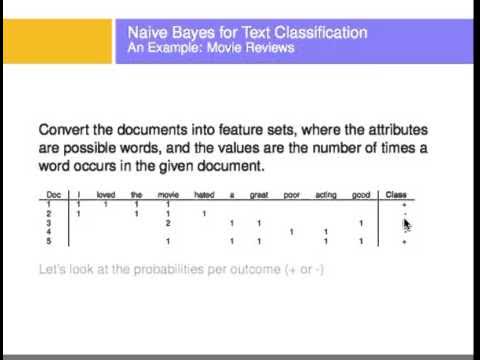AIP.NP1.Text Classification with TensorFlow
Summary
TLDRThis script offers an introduction to building a text classification model using TensorFlow, focusing on binary classification of movie reviews as positive or negative. It guides through setting up the environment, importing necessary libraries, and utilizing TensorFlow Hub for transfer learning with a pre-trained model. The tutorial covers data preparation, model creation with a sequential approach, compilation, and training. The final model achieves an accuracy of 84.3% in predicting review sentiments, demonstrating a basic yet effective application of TensorFlow for text classification.
Takeaways
- 📚 The script introduces a basic project of text classification with TensorFlow, focusing on movie reviews which can be classified as either positive or negative.
- 🔍 It outlines a binary classification problem that is widely applicable to various applications, not just movie reviews.
- 💻 The project uses TensorFlow Hub for transfer learning, leveraging a pre-trained model trained on over 50,000 movie reviews.
- 📈 The dataset is split into training and testing sets, with an equal number of positive and negative reviews in each set, ensuring a balanced dataset.
- 📝 The script guides through the process of creating a new Jupyter notebook file for the project and importing necessary libraries.
- 🔧 It details the steps to import TensorFlow and TensorFlow datasets, and suggests installing them via pip if not already installed.
- 🔗 The project utilizes TensorFlow Hub to embed sentences from the movie reviews, which is a crucial step in the text classification model.
- 🌟 The script explains the creation of a Keras model with a TensorFlow Hub layer and additional dense layers for the classification task.
- 🔧 The model is compiled with the Adam optimizer and binary crossentropy loss function, focusing on accuracy as the main metric.
- 🚀 The training process is described, including setting the batch size, number of epochs, and validation data to monitor the model's performance.
- 📊 The script concludes with evaluating the model's performance on the test dataset, achieving an accuracy of around 84.3%, indicating the model's effectiveness in classifying movie reviews.
Q & A
What is the main focus of the project described in the script?
-The main focus of the project is to create a basic text classification model using TensorFlow, specifically for classifying movie reviews as either positive or negative.
What type of problem is the text classification of movie reviews considered to be?
-It is considered a binary classification problem because it involves classifying the reviews into two categories: positive or negative.
Which dataset is used for this project and where is it sourced from?
-The dataset used is the IMDb reviews dataset, which is sourced from TensorFlow itself.
What is TensorFlow Hub and how is it used in this project?
-TensorFlow Hub is a library and platform that provides pre-trained models. In this project, it is used to fetch a pre-trained model for text embedding, which is then used in the text classification model.
What is the purpose of transfer learning in the context of this project?
-Transfer learning is used to leverage a pre-trained model from TensorFlow Hub that has been trained on a large dataset of movie reviews, allowing the new model to benefit from this pre-existing knowledge without starting from scratch.
How is the dataset split in this project?
-The dataset is split into training data, validation data, and test data. The training data is further split into 60% for training and 40% for validation.
What is the role of the embedding layer in the TensorFlow model?
-The embedding layer is used to convert the input text data into a numerical format that can be processed by the neural network. It uses a pre-trained model from TensorFlow Hub for this purpose.
What activation function is used in the dense layer of the model and why?
-The ReLU (Rectified Linear Unit) activation function is used in the dense layer because it introduces non-linearity to the model, allowing it to learn more complex patterns in the data.
How is the model compiled in the script?
-The model is compiled using the 'model.compile' function with the Adam optimizer, binary crossentropy as the loss function, and accuracy as the metric to evaluate.
What is the significance of the accuracy achieved on the test dataset?
-The accuracy achieved on the test dataset, which was around 84.3%, indicates how well the model is likely to perform on unseen data, suggesting that it has learned to classify movie reviews effectively.
How can the trained model be deployed for real-world applications?
-The trained model can be saved and deployed using TensorFlow's saving and serving mechanisms, such as TensorFlow Serving, which allows the model to be used in real-world applications for predicting whether a movie review is positive or negative.
Outlines

This section is available to paid users only. Please upgrade to access this part.
Upgrade NowMindmap

This section is available to paid users only. Please upgrade to access this part.
Upgrade NowKeywords

This section is available to paid users only. Please upgrade to access this part.
Upgrade NowHighlights

This section is available to paid users only. Please upgrade to access this part.
Upgrade NowTranscripts

This section is available to paid users only. Please upgrade to access this part.
Upgrade NowBrowse More Related Video

Text Classification: AI Techniques and Real-World Applications

What is Classification? What is a Classifier?

Tutorial Klasifikasi Teks dengan Long Short-term Memory (LSTM): Studi Kasus Teks Review E-Commerce

PNEUMONIA Detection Using Deep Learning in Tensorflow, Keras & Python | KNOWLEDGE DOCTOR |

Image Classification App | Teachable Machine + TensorFlow Lite

Text Classification Using Naive Bayes
5.0 / 5 (0 votes)